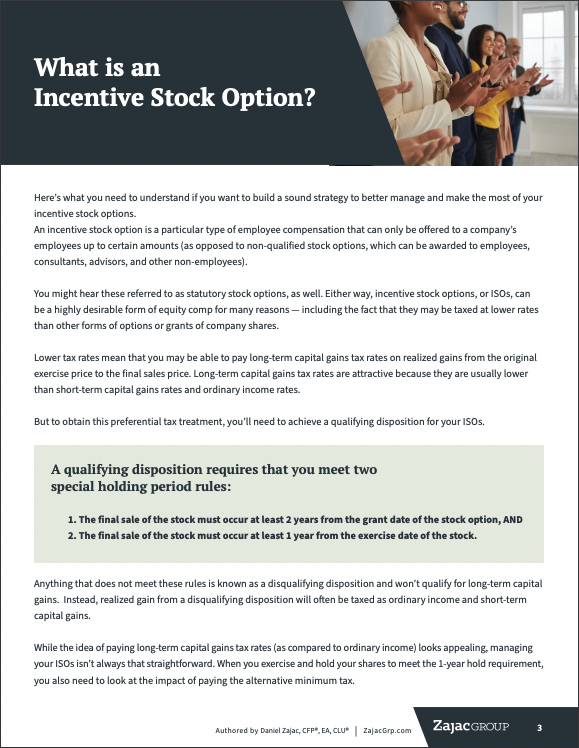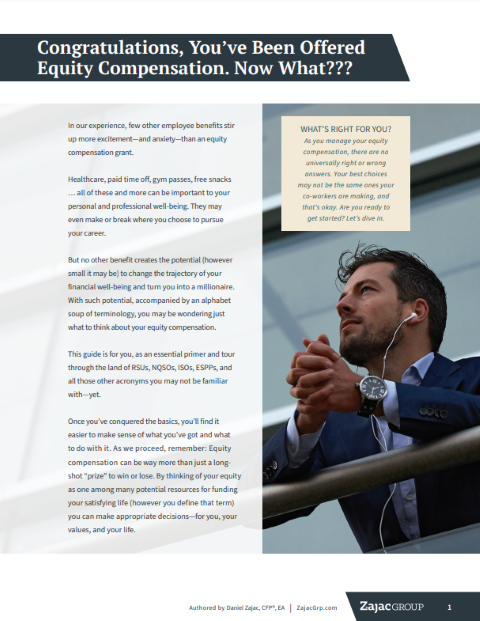
Some strategies suggest that exercising early may be a good idea, because this is when the impact from the alternative minimum tax, or AMT, may be lowest. Others suggest it’s best to exercise as late as you can. Waiting provides more clarity as to the final value of the stock options, and your incentive stock options become a use it (exercise) or lose it (the stock option expires) situation.
Exercising early or exercising late aren’t your only two options. Instead, you might want to consider an exercise and hold up the AMT crossover point, or the point where you tentative minimum tax equals your regular tax. Or more simply, the point where you can exercise and hold ISO and not incur AMT.
In a limited sense, an exercise up to the AMT crossover point strategy might provide you with a way to “have your cake and eat it too.”
With good planning, you can exercise a specific number of ISOs without incurring any AMT. Once exercised, the held shares of stock begin the holding period to obtain a qualifying disposition.
Unfortunately, the details of this implementing an exercise up to the AMT crossover point may get a little confusing. Let’s walk through them together.
FREE GUIDE
The Ultimate Guide to Incentive Stock Options
Learn the ins and outs of incentive stock options so you gain a better understanding of what you have.
Changes in the Way Alternative Minimum Tax is Calculated Due to the 2017 Jobs Tax Act
The exercise to the AMT crossover strategy has always been an option if you have incentive stock options and good tax planning skills. The 2017 Jobs Tax Act expanded that opportunity because it changed the way AMT will be calculated in 2018 and beyond.
The 2017 Jobs Tax Act made changes to increase exemptions and increase when phaseouts of said exemptions occur when calculating AMT. This is all a fancy way of saying that it is likely less people will be subject to AMT in 2018 and beyond.
Moving into 2019 and 2020, key figures for the exemption and phaseout are as follows:
| 2019 Exemption | 2020 Exemption | 2019 Phaseout | 2020 Phaseout | |
| Single | $71,700 | $72,900 | $510,300 | $518,400 |
| Married File Joint | $111,700 | $113,400 | $1,020,600 | $1,036,800 |
For those with ISOs, a byproduct of the 2017 Jobs Tax Act may have created an opportunity for a larger AMT free exercise of incentive stock options than previously eligible.
Before we dig into a hypothetical example, let’s recap what we should already know about ISOs and the AMT.
Incentive Stock Options and the AMT
When you exercise and hold incentive stock options, you likely do so with the hope of obtaining a qualifying disposition. A qualifying disposition is one when the final sale of the stock occurs at least 2 years from the grant of the incentive stock option and one year from the exercise date of the option.
The result of a qualifying disposition is that the value from the strike price of the ISO to the final sales price is treated as a long-term capital gain (assuming there is a gain in value).
What complicates this strategy is the AMT. AMT is based on a secondary tax calculation that occurs every year you file a tax return known as the tentative minimum tax.
As a taxpayer, you generally pay the higher of the regular tax calculation and the tentative minimum tax. AMT is what you pay when the tentative minimum tax is higher than the regular tax.
When you exercise and hold incentive stock options, the bargain element (the difference between the strike price and the fair market value at exercise, multiplied by the number of options exercised) is included in the calculation of the tentative minimum tax. That potentially makes the tentative minimum tax the higher of the two calculations, leaving you on the hook for paying AMT.
To effectively exercise and hold ISO to the AMT crossover point is the spread between the regular tax and tentative minimum tax. The smaller the spread between the two, the smaller the opportunity. The greater the spread, the greater the opportunity.
All else being equal, the 2017 Jobs Tax Act increased the spread between the two. This means you can likely exercise more of the bargain element than previously allowed, which leads to a greater planning opportunity.
AMT Crossover Point Example when Exercising Incentive Stock Options
Using a hypothetical example, we can illustrate how to exercise and hold ISOs up to the AMT crossover point.
We will use a simple tax return with a few assumptions for our illustration:
- Our taxpayers are married couple and both spouses are 55; no kids
- They file as Married Filing Jointly on their tax returns
- They earn $250,000 of gross annual income
- They take the standard deduction
A Hypothetical Tax Analysis
When we plug the above information into a hypothetical tax return, we can calculate two key numbers: regular tax and the tentative minimum tax.
Simplifying a return, we see the following:
| Regular Tax | Tentative Minimum Tax | ||
| Total Income | 250,000 | Alt Min Taxable Income | $250,000 |
| Taxable Income | 226,000 | AMTI Less Exemption | $138,300 |
| Regular Tax (20%) | $45,200 | AMT (26%) | $35,958 |
As you can see, the regular tax is $45,200 and the tentative minimum tax is $35,958. As the regular tax is the higher of the two calculations, this household will be required to pay $45,200 in tax.
When planning an AMT crossover strategy, you want to review the spread between the two calculations. In this scenario, the spread is $9,042.
At this point, we need to ask:
- How many incentive stock options can you exercise and hold and have the regular tax calculation be the higher of the two?
- How much of bargain element (the difference between the strike price and the FMV at exercise, multiplied by the number of shares exercised) can you incur until you reach the AMT crossover point?
A simplified calculation is dividing the spread by 26% (26% is being used as our AMT tax rate)
($45,200 – $35,958) / 0.26 = $34,777
In this simple calculation, these taxpayers could exercise and hold $34,777 of the bargain element and still pay no AMT.
If we wanted to be exact in our calculation, it would be necessary to go back to actual tax software to project the return. If your tentative minimum tax is higher than your regular tax, you may be able to modify by lowering the bargain element. Alternatively, if your tentative minimum is below the regular tax, you may be able to capture more bargain element.
Applying These Examples to Your Incentive Stock Option Grants
Once you know the amount of the bargain element you can capture, you can circle back to your incentive stock option grants to determine how many options you can exercise. Let’s assume you have the following grants:
| Shares | Strike Price | Exercise Price | Bargain Element | |
| Grant 1 | 10,000 | $1.00 | $25.00 | $240,000 |
| Grant 2 | 10,000 | $5.00 | $25.00 | $200,000 |
As you can see from the line on the right, if you exercised all of the grants above, you incur $440,000 from the bargain element. But the goal is to exercise only enough to reach the crossover point.
To do so, we need to calculate how many shares you could exercise to reach $34,777 worth of the bargain element for 2018.
If we assume that you exercise shares from Grant 1, the math is as follows:
“Shares to Exercise” X (FMV at Exercise – Strike Price) = Bargain Element
“Shares to Exercise” X ($25 – $1) = $34,777
“Shares to Exercise” = 1,449 (rounded down)
If we assume that you exercise shares from Grant 2, the math is as follows:
“Shares to Exercise” X ($25 – $5) = $34,777
“Shares to Exercise” = 1,738 (rounded down)
While you can exercise more shares if you are doing exercise grant 2, you may also want to pay attention to the cash flow required to do so. When you exercise your ISOs, you will need to pay for the shares. The cost of each exercise is:
Shares Exercised X Grant Price
Grant 1 Cost = 1,449 X $1 = $1,449
Grant 2 Cost = 1,738 X 5 = $8,690
In this example, the cost of Grant two is materially higher than the cost of grant 1. A full decision about AMT crossover should include the cost of the AMT as well as the cost of exercising and holding said shares.
The Benefits of The AMT Crossover Point Strategy
If you followed the details of the above analysis, you might notice you don’t actually save income tax in the year you exercise up to the AMT crossover point. So what, if any, value does this complicated strategy have?
The first benefit is a future tax savings opportunity. If you implement this strategy correctly, you will not pay AMT (or you will pay limited AMT) on the exercised ISOs. If you do not implement this strategy, it is reasonable to assume that you’ll exercise your ISOs in a year when you are subject to AMT.
For example, in lieu of exercising some options each year, you might exercise an entire grant in a single year. If we assume this is true, and we assume that the ISOs will be subject to AMT in the future, they will be taxed at the requisite AMT rate in that year.
If we compare exercising ISOs at zero cost today versus 28% later, we have a clear winner. The tax savings opportunity is 28% in opportunity cost.
(To be fair, some or all of the 28% AMT you pay may come back to you as an AMT credit in future tax years. In this sense, it’s not a total 28% savings. On the other hand, AMT also may cause a cash call need that you could avoid with the AMT crossover strategy).
The second benefit of this strategy is that it starts the holding period for a qualifying disposition of some of your shares. This means that after 1 year from exercise, you will have a portion of your shares that are eligible to be solid in a preferential tax treatment via qualifying disposition. This creates liquidity that you may not have otherwise had.
For example, imagine that you need $X amount of dollars but did not follow the above strategy. To get that money, you’d likely need to do a disqualifying disposition of ISOs, meaning a higher tax bill as you wouldn’t meet the requisite holding periods (assuming you cannot go somewhere else for the money).
A third benefit is the cumulative effect of this annual exercise strategy. In our example, you can exercise $34,777 without incurring AMT. If you do this year over year, for 10 straight years, you could exercise and hold nearly $350,000.
Ultimately, every tax situation is different and you should run a detailed tax calculation on your own (or with the help of an advisor). But the opportunity is one that should be explored if you hold incentive stock.
Summing It All Up
The exercise up to the AMT crossover point is nothing new. What is new is the changing tax laws that may create additional room to exercise and hold more incentive stock options each year. As the opportunity to exercise and hold gets bigger, so does the opportunity to take advantage of this with good planning.
This material is intended for informational/educational purposes only and should not be construed as investment, tax, or legal advice, a solicitation, or a recommendation to buy or sell any security or investment product. Hypothetical examples contained herein are for illustrative purposes only and do not reflect, nor attempt to predict, actual results of any investment. The information contained herein is taken from sources believed to be reliable, however accuracy or completeness cannot be guaranteed. Please contact your financial, tax, and legal professionals for more information specific to your situation. Investments are subject to risk, including the loss of principal. Because investment return and principal value fluctuate, shares may be worth more or less than their original value. Some investments are not suitable for all investors, and there is no guarantee that any investing goal will be met. Past performance is no guarantee of future results. Talk to your financial advisor before making any investing decisions.







Great summary, Daniel. Thank you.
The next question becomes “what is the tax implication of exercise & hold if the held shares subsequently increase in value before a qualifying disposition”?
For example, lets say that your owner of 20,000 ISOs exercises all of them in one year (i.e. no crossover strategy). They pay $60,000 in exercise price and, incur $440,000 in bargain element, and (for the purposes of this example) lets say they pay $120,000 in AMT during the exercise year. They do not take any AMT credits the next year. Two years after exercise they have a qualifying disposition of all 20,000 shares at $50/share for gross proceeds of $1,000,000. What is used for the cost basis of the shares at the time of disposition to determine the taxable gain?
Is it
a) $60,000 (the exercise cost)
b) $180,000 (the exercise cost plus the AMT paid)
c) $440,000 (the bargain element from the exercise year)
d) $500,000 (the exercise cost + the bargain element from the exercise year)
e) Something else entirely
Hi Rob – Thanks for the comment.
When you exercise and hold ISO, you will likely have “dual basis”. One basis for calculating your regular tax and long term capital gains, and a second AMT basis for calculating and the AMT credit.
Based on the example you used, and what I think I am reading, the basis for regular tax will be the original $60,000 exercise cost. The AMT basis will be $500,000.
When you sell the ISO shares, assuming a qualifying disposition, you will likely pay long term capital gains tax on gain from $60,000 to $1,000,000 (and maybe other tax as well https://www.danielzajac.com/4-taxes-to-plan-for-when-you-sell-your-incentive-stock-options/).
You may receive an AMT credit due to the AMT basis and how this impacts your tentative minimum tax
Keep in mind, this can be complicated. And what I have here is not specific tax advice. Its meant to be a representation of what may happen. You may want to consult a professional to help with your needs.